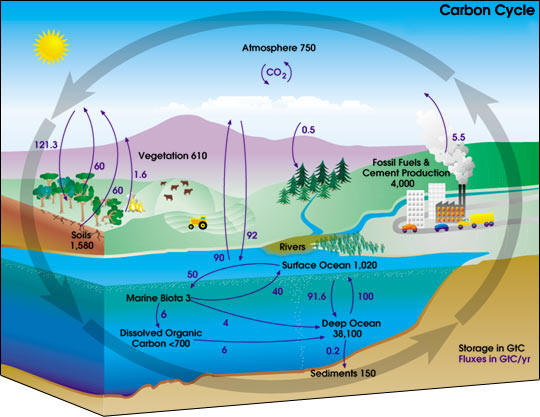2.5.3: Carbon Cycle
- Page ID
- 15850
Carbon is the fourth most abundant element in the Universe and is the building block for all living things. The conversion of carbon dioxide into living matter and then back is the main pathway of the carbon cycle. Plants draw about one quarter of the carbon dioxide out of the atmosphere and photosynthesize it into carbohydrates. Some of the carbohydrate is consumed by plant respiration and the rest is used to build plant tissue and growth. Animals consume the carbohydrates and return carbon dioxide to the atmosphere during respiration. Carbohydrates are oxidized and returned to the atmosphere by soil microorganisms decomposing dead animal and plant remains (soil respiration).
Another quarter of atmospheric carbon dioxide is absorbed by the world's oceans through direct air-water exchange. Surface water near the poles is cool and more soluble for carbon dioxide. The cool water sinks and couples to the ocean's thermohaline circulation which transports dense surface water toward the ocean's interior. Marine organisms form tissue containing reduced carbon, and some also form carbonate shells from carbon extracted from the air.

(Courtesy NASA, Source: earthobservatory.nasa.gov/Li...on_cycle4.html)
There is actually very little of the total carbon cycling through the Earth system at any one point in time. Most of the carbon is stored in geologic deposits - carbonate rocks, petroleum, and coal - formed from the burial and compaction of dead organic matter on sea bottoms. The carbon in these deposits is normally released by rock weathering.
Video: Keeping Up With Carbon (Courtesy NASA (Source))
Understanding how the carbon cycle is changing is key to understanding Earth's changing climate.


